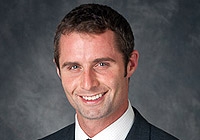Conor Reardon '14

If it takes composure, resilience, and a fearless work ethic to succeed in law school, Conor Reardon arrived at Duke particularly well prepared. He first honed those skills in sports, playing baseball at Brown University and fighting back from a debilitating injury to become an All-American standout. And he perfected them trying to connect with economically challenged middle school students as a member of the Teach-for-America corps.
Reardon is clearly succeeding at Duke, where he is a notes editor for the Duke Law Journal and has already lined up two post-graduate clerkships in his home state of Connecticut, the first with U.S. District Court Judge Robert Chatigny, and the second with Judge José Cabranes of the U.S. Court of Appeals for the Second Circuit.
Reardon was home in Branford, Conn., for Thanksgiving during his sophomore year at Brown when he was struck by a car in his driveway. He was in the hospital for three weeks, one leg so badly damaged that his doctors considered amputation. To save it, Reardon endured four operations and was on crutches for months. He missed the rest of his fall semester and had to take extra classes to catch up in the spring.
“It was a rough time,” Reardon says. “Looking back, I know the extra work was good for me. I learned a lot about discipline — a 19-year-old boy can stand to learn a lesson or two about hard work.”
The hard work involved more than academics. Reardon’s doctor told him that he would be lucky to be fully mobile again, and that he certainly wouldn’t return to baseball. Nonetheless, he worked hard at strengthening his leg, and finally saw progress just before his senior year. That fall, friends from the baseball team convinced him to walk down to the field with them.
“I was just messing around, taking a little batting practice,” Reardon says. “I was surprised to find I could still hit the ball.” The coach was impressed enough to suggest he suit up for the next game. Reardon did, hoping he would get a chance to pinch hit. Instead, he played the whole game as designated hitter, with two hits in four at bats. “Fall baseball is pretty low key,” he says with a laugh. “No one cared that I couldn’t run.”
In the spring, he did have to run. “Luckily, baseball is a meandering kind of sport,” he says. “There are very few times where an all-out sprint is required.” He ended up starting every game as the designated hitter and finished the season with a .395 average. As a freshman, before his injury, his batting average was .286. He made ESPN The Magazine’s second team Academic All-American and was named the Brown Bears’ MVP.
Reardon’s “Award of Valor” from the Eastern College Athletic Conference could just as easily apply to his three years after college when he taught history and literature at a Title 1 middle school in Bridgeport, Conn., as a Teach-for-America recruit.
“Standing up in front of those rowdy middle school kids was a challenge,” he says. “You couldn’t do the ‘whack-a-mole’ thing, constantly trying to control every student who acted out.” Instead, Reardon aimed to develop a relationship with every student, so that each one would want to do the right thing, putting in extra hours before school, after classes, after school and during detention to make this work. “It turned out to be the most valuable initial work experience I could have had,” he says. “It was totally draining, but never dull.”
As a follow-up, Reardon chose law, a profession he had been exposed to early on. Growing up in Branford, his father, an inspector with the State’s Attorney’s Office, would take him to baseball games with a group of story-telling state attorneys. “Criminal justice seemed interesting but opaque,” he says.
Now, Reardon finds that the impenetrable nature of law is exactly what attracts him to the legal profession. “I love studying cases,” Reardon says. “In each case, there’s so much going on at so many different levels — applicable case law, statutory history, judicial opinions about policy. All of that, and then the case is decided because of a specific set of facts — sometimes absolutely egregious facts, and endlessly fascinating. Proximate cause in torts is just weird.” Reading cases for torts class made Reardon reflect on his own accident. “But,” he says, “that was not interesting factually. It was pretty straightforward.”
If his accident was pretty straightforward from a legal point of view, Reardon was so engaged by the facts of a case he came across working in the New Haven District Attorney’s Office during his 1L summer that he used it as the basis for a DLJ note. A woman who filmed a bar fight and subsequent scuffle with arresting officers had her cell phone camera confiscated by the police for 10 days. “At the time, I looked into whether it was legal for the cop to take the camera, and the Fourth Amendment says yes, it was fine,” Reardon says.
But he kept thinking about the case — and back at Duke he decided to further explore a possible conflict with the First Amendment right to free speech. In his forthcoming note, he proposes that in similar cases the First Amendment should inform Fourth Amendment issues.
Reardon looks forward to studying a wide variety of cases during his two clerkships, after which he plans to work at a law firm in Boston. He hopes to write more articles in any extra time he finds. “When you happen upon an interesting topic, the paper almost writes itself,” he says.
-- Caitlin Wheeler ’97